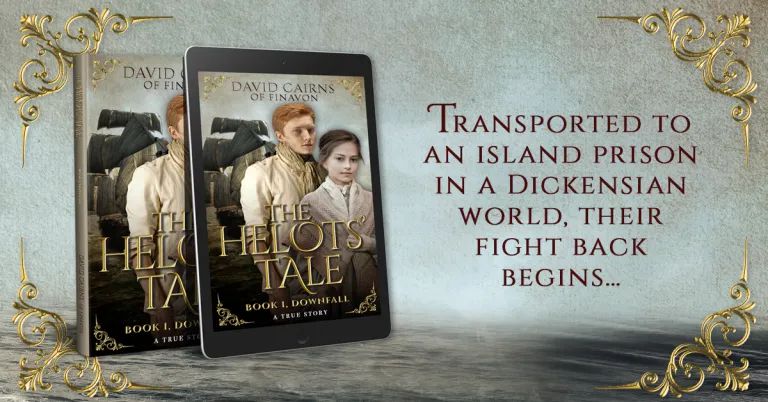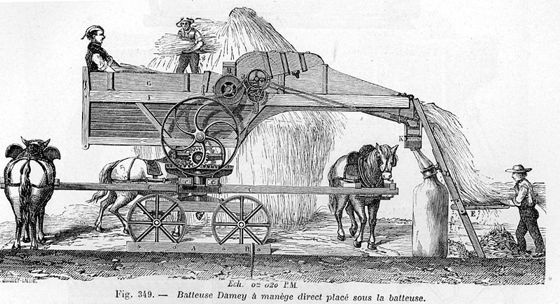
Blurb
◆ A true story.
How would you respond if your death sentence was commuted to life on an island prison half a world away?
Starting amongst the smog-laden streets of Victorian London, experience the life and times of Robert Bright and Mary Ann Goulding; real people caught up in the hopelessness of an unequal, class-ridden society who fight back as the new nation of Australia is forged.
The Helots’ Tale is a deeply-researched two-part novel that transports the reader back in time, weaving intriguingly amongst the real people and real events of an age when the British Empire was in full flow. It describes the adventures of two of the 160,000 souls transported to the new world colonies of Australia in the 1800s.
Resurrection of a kind: the history behind the story
In writing his recent series of historical novels, author David Cairns, the Baron of Finavon, discovered his family’s past
When my wife, Victoria and I were visiting Tasmania for the first time, we called in at the Female Factory building in Hobart. This is the ruins of a prison in the 1800s built to house and work female convicts transported from England. We were there because Victoria had become aware that an ancestor of hers, a young girl named Mary Ann Goulding, had possibly been sent there for stealing a cloak in London in 1834 and she was hoping to find out if there were any traces of her in the Factory’s records.
As far as we knew, Mary Ann existed only as a few lines on a page in a book sitting on a dusty shelf of a forgotten library. We knew the date she arrived in Hobart, the ship on which she arrived, her crime and her sentence and a few words purporting to describe her appearance. Her age was uncertain as her mother had claimed she was 13 – probably to avoid transportation – other records said 19. All else was, to us, an undiscovered country.
So when we crossed the threshold this hot, sunny day into the cool shade of the cramped Factory office we weren’t expecting much. We asked if they held any relevant records and, after a computer check, the librarian went to a shelf of dog-eared ledgers and pulled one down. She placed it on the desk and opened it. There, in cramped handwriting was our Mary Ann.
I could almost see the clerk casting his eye over a defiant Mary Ann standing under guard in front of him. I could almost hear him scratching at the paper with his quill pen, noting in a spidery scrawl that she had been found with a bolt of fabric so she must be a thief and therefore it was away to solitary confinement on bread and water. Putting his quill down and blotting the page, he would have dismissively packed her off and moved on to the next unfortunate. There were other entries too and as I read, this indomitable, pint-sized young woman began to take shape before me.
So began my quest to bring Mary Ann back to life.
Even the little information I had was often wrong, for example she hadn’t stolen a cloak, but a clock. From a shop on Regent Street where Top Shop sits today. She walked off with her two friends towards Bond Street with it concealed under her cloak until she was stopped by a policeman and the shop assistant. I have walked that same stretch of pavement many, many times and although much has changed, much has stayed the same.
I also began digging into the life story of the man she married in Launceston and working backwards and forwards began to weave the complex tapestry of the lives of both her and her husband, Robert Bright, a transported Cambridge farm labourer.

Anyone who has read a Dickens novel has a feel for the period. It was an age of grinding poverty, when hope was an easily extinguished flame. An age of suffocating pollution and filth if you lived in a big city. An age when the underbelly of society was beginning to flex its muscles in response to the hunger and injustice of life.
I was a keen history student at school and gobbled up all I was taught but I guess there’s only so much they can teach you. I was surprised at how much I hadn’t been taught about this period. I had heard of the Peterloo Massacre and the Tolpuddle Martyrs for example but the Swing Riots had passed me by – which is incredible given the significance of the agricultural uprisings in 1830 across much of England (Captain Swing by Hobsbawm and Rude´ is perhaps the definitive study).
I was struck by a notice issued by Norfolk magistrates in November 1830. It begins:
The Magistrates in the Hundreds of Tunstead and Happing, in the county of Norfolk, having taken into consideration the disturbed state of the said Hundreds and the County in general, wish to make it publicly known that it is their opinion that such disturbances principally arise from the use of Threshing Machines, and to the insufficient Wages of the Labourers.

The cry was that the threshing machines kept an honest man from work and Captain Swing – a mythical figure – would destroy any who employed this instrument of the devil. Swing’s followers made good on the threat. The riots were put down violently but a message had been sent demanding social reform which, in part, led to the Reform Act of 1832.
Robert Bright was sentenced to death for house-breaking the same year even though the prosecutor (yes, you read that right, the prosecutor) pleaded with the judge for mercy. Life could hang by a thread. The Reform Law Act included removal of the death penalty for housebreaking, horse and sheep stealing and forgery. However, Robert and his co-defendant William Cousins had been sentenced shortly before this became law. Had they delayed their adventure by a few months they would have received a different sentence.
In the event, their sentence was commuted to 7 years transportation but it must have been an anxious few weeks in the Cambridge cells waiting to hear if they were going to end their short lives on the scaffold or if their appeal had been successful.
In the new world frontier of Australia Mary Ann and Robert became little more than slaves providing free labour in a land ruled by nepotistic despots who, like the Russian autocrats and oligarchs of today milked the system to fatten their own wallets. Ironic, seeing as Britain had by now abolished slavery.
But they both stood firm, served their time and left Van Diemen’s Land together for the frontier town of Melbourne to join the greatest gold rush the world had ever seen with tens of thousands of prospectors descending like locusts on bushlands with pick and shovel to seek their fortune. Alongside them came the bushrangers seeking easy pickings and the British government enforcers taking their unearned cut.
It was a repeat, in its own way, of what had gone before in England and it led to one of the most singular events in Australia’s history, the massacre at the Eureka Stockade where lightly armed miners protesting their own injustices were ruthlessly ridden down by British soldiers and police. Like the reaction in England with the Reform Act, such was the outcry in Melbourne that the survivors who had been put on trial were acquitted and less onerous laws were brought in to defuse the situation.
The Helots’ Tale tells the story of two remarkable people in a remarkable time and I can only say that I am gratified to be able to say that descendants of this couple who have read my story have come to know their forbears in a way that would not have been possible before. Victoria told me that the books had brought Robert and Mary Ann to life for her.
Alive again. No longer just dry words on a fading page sitting on the dusty shelf of a forgotten library.
The Helots’ Tale: Downfall and Redemption are launching on 30th June by David Cairns, the Baron of Finavon are available online: https://amzn.to/3yYQ1Dd
Meet David Cairns

David Cairns, the Baron of Finavon (an ancient Scottish title), has always been a student of history and has the ability to create an atmosphere and three–dimensional experiences with his writing style. Until recently, he was a technology entrepreneur. He has lived and worked on four continents and as a result has experienced the history of London and Boston, the buzz of Chicago, Nashville and Silicon Valley, the pioneering atmosphere of the South African bush, the lazy lifestyle of the Bahamas, the cultural diversities of Europe and the laid-back lifestyle of Australia, which is where he makes his home these days. https://cairnsoffinavon.com/published/
Twitter: https://twitter.com/TheDavidCairns